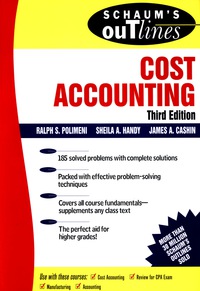Question
Case Study Supreme Inc. You have just joined the Supreme Company as a financial analyst, reporting to the Controller. Based upon your recent business education
Case Study Supreme Inc.
You have just joined the Supreme Company as a financial analyst, reporting to the Controller. Based upon your recent business education at Humber, which included a wide range of subject areas, your new boss has asked you to help her review the recent changes in the manufacturing area.
Until recently, the company had offered only a limited number of standard electric motors for sale. They had purchased raw materials and the lowest level components, but produced most of the subassemblies and all of the finished products in their own plant. The companys profitability had declined over the years and marketing believed that customers needed both more variety of product and lower prices. In early 2014, the manufacturing division had been assigned the task of recommending changes to accomplish this dual goal of increasing variety and reducing costs.
Manufacturing had recommended that they change their strategy to:
- Buy (rather than make in-house) most of the subassemblies.
As tooling-up to produce a much wider variety of subassemblies, would take several million dollars of investment and 2-3 years to implement. Retaining production of existing sub-assemblies in-house was not considered viable as their volumes were expected to drop dramatically, when the variety being offered increased. Also the company needed all the existing space for the more flexible final assembly process needed for the greater variety of products being sold.
- Build final products to customer order.
This plan had been approved in September of 2014. The plan and associated personnel layoffs were announced in October 2014, with the layoffs scheduled for December 31, 2014. The increased variety of products had been announced in October, with the first build-to-order shipments scheduled for Jan 2015.
Selected Historical Results:
| Period | Sales ($ '000's) | Labour ($ '000's) | Material ($ '000's) | Other Costs ($ '000's) |
| Jan 2014 | 250 | 63 | 104 | 65 |
| Feb | 252 | 62 | 102 | 66 |
| Mar | 262 | 65 | 103 | 64 |
| April | 255 | 64 | 106 | 66 |
| May | 263 | 66 | 103 | 63 |
| June | 270 | 69 | 104 | 65 |
| July | 265 | 68 | 102 | 64 |
| Aug | 262 | 66 | 108 | 67 |
| Sept | 254 | 69 | 107 | 66 |
| Oct | 259 | 75 | 109 | 65 |
| Nov. | 265 | 76 | 115 | 69 |
| Dec | 268 | 77 | 120 | 70 |
| Jan 2015 | 255 | 51 | 156 | 64 |
| Feb | 265 | 47 | 150 | 63 |
| Mar | 275 | 35 | 149 | 64 |
| April | 290 | 31 | 144 | 65 |
| May | 284 | 30 | 146 | 63 |
| June | 286 | 31 | 147 | 65 |
| July | 295 | 29 | 148 | 64 |
| Aug | 292 | 29 | 148 | 63 |
| Sept | 301 | 31 | 150 | 65 |
Assignment: Compile a report, which includes the following:
2- Calculate Labour, Material and Total Productivity (multifactor of all costs) indices, for each month and present them in a table. IE. Three indices for each month. (15 marks)
3- Present the 3 indices calculated in Point 2, in a line graph format, on one page. (10 Marks)
4- Compare the 3 average productivity indices for the whole of 2014 (12 months) with the 3 average indices of July-September (only 3 months) of 2015. a) What is the percentage change for each index? (12 marks) b) Why do we use only 3 late months in 2015? (3 marks)
5- Did the change in manufacturing strategy deliver improvements? Comment on patterns of Total Productivity, Labour Productivity and Material productivity, before and after the change in strategy and explain the reasons for each of the 3 patterns. IE. Mention the reason(s) that a productivity index went up or down. (10 Marks)
6- Comment on the role of Inspection:
a) In general (One page) (8 marks)
b) When (how often?) and where (which step of their manufacturing process?) should
Supreme inspect (+-half page)? (7 marks)
7- Does higher quality (producing a good or a service with less mistakes/rejects) increase productivity? Explain your answer. (10 marks)
8- Six Sigma
a) Search the Internet to find two organizations that use Six Sigma.
List the specific Website address of each organization. (5 marks)
b) Describe the use of Six Sigma in one
Step by Step Solution
There are 3 Steps involved in it
Step: 1

Get Instant Access to Expert-Tailored Solutions
See step-by-step solutions with expert insights and AI powered tools for academic success
Step: 2

Step: 3

Ace Your Homework with AI
Get the answers you need in no time with our AI-driven, step-by-step assistance
Get Started


